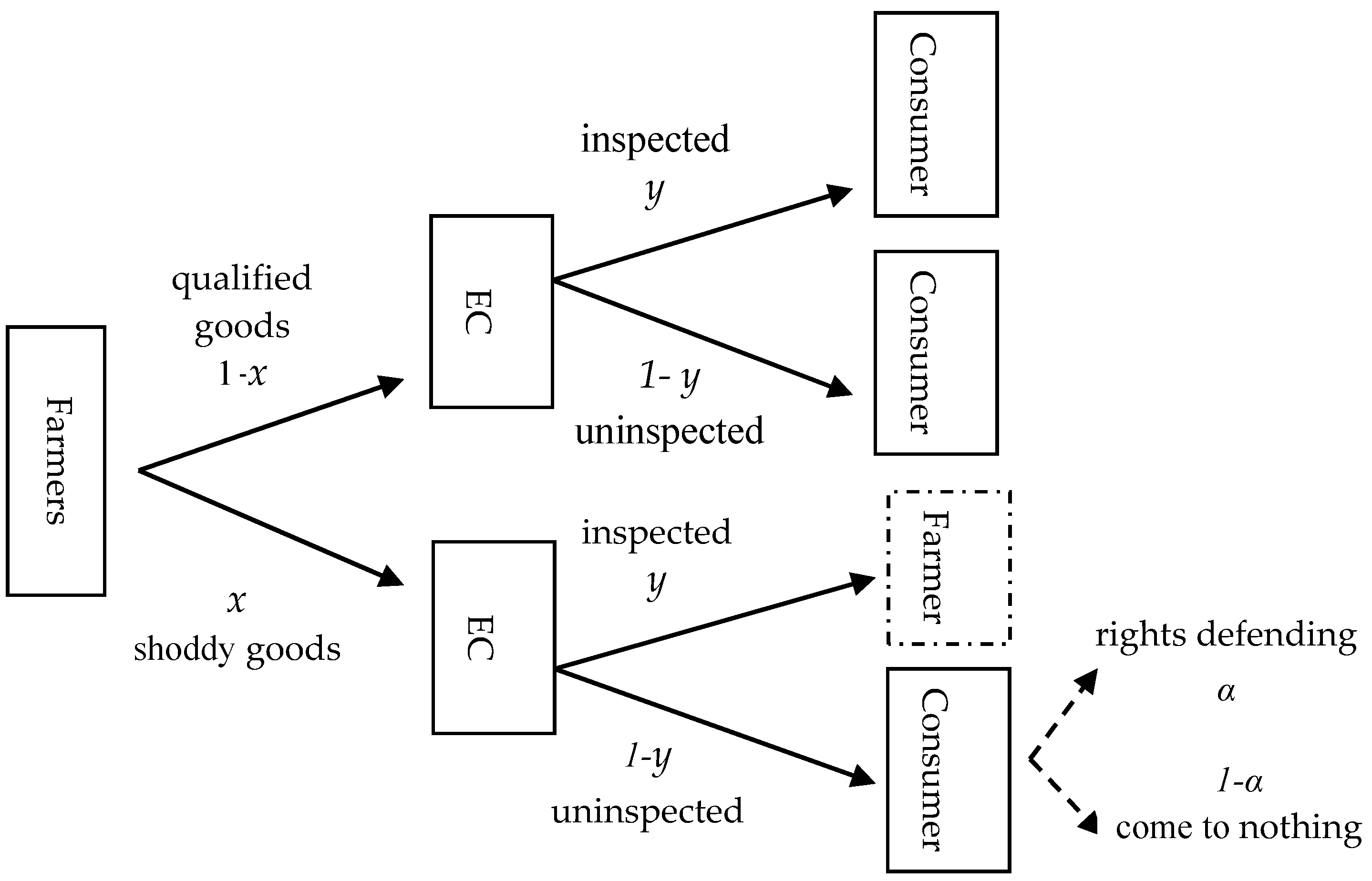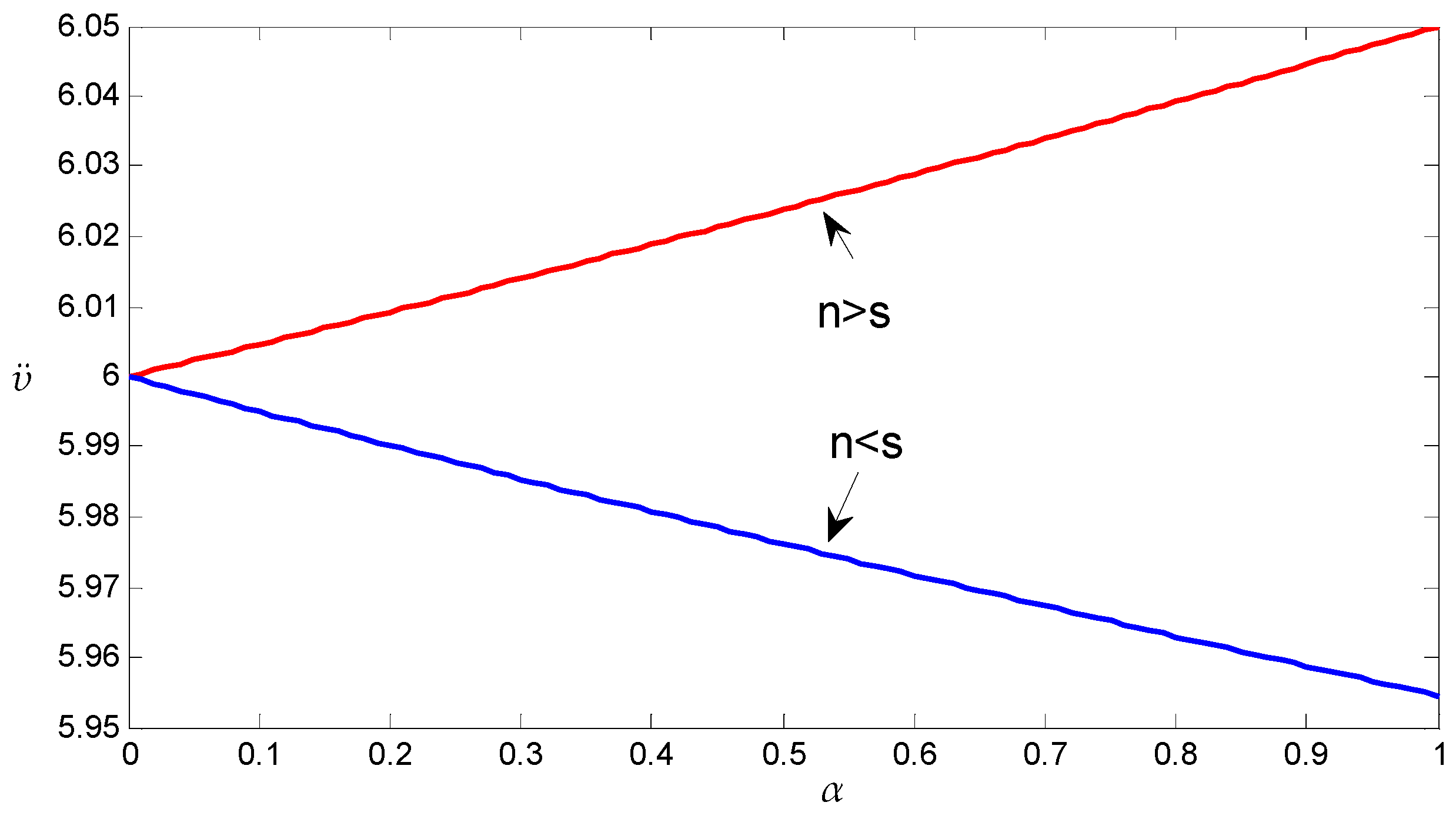Quality Decision-Making Behavior of Bodies Participating in the Agri-Foods E-Supply Chain
Abstract
:1. Introduction
2. Relevant Literature Review
3. Materials and Methods
3.1. Problem and Symbol Description
3.2. Model Setting
- Step 1: The EC finds proper agri-food providers who are willing to build a relationship. The EC announces the buying price and inspection rules.
- Step 2: The farmer chooses to provide qualified agri-foods as required or mixes them with low-level products. The quality information of the agri-foods is also known.
- Step 3: The EC decides whether or not to inspect the agri-foods and to continue with the common selling procedures.
4. Results
4.1. Theoretical Derivation
4.2. Example Analysis and Simulation
5. Discussion
6. Conclusions
Author Contributions
Funding
Conflicts of Interest
References
- Song, X. Five Strategic Thoughts on Digital Transformation of Traditional Enterprises. Total Corros. Control 2015, 29, 18–19. [Google Scholar]
- Ji, C.; Chen, Q.; Zhuo, N. Enhancing consumer trust in short food supply chains. J. Agribus. Dev. Emerg. Econ. 2019. [Google Scholar] [CrossRef]
- Fang, X. Why does agricultural product logistics “Smile in the middle, and cry in both heads”. Guide Chin. Poult. 2003, 18, 28. [Google Scholar]
- Renting, H.; Marsden, T.K.; Banks, J. Understanding alternative food networks: Exploring the role of short food supply chains in rural development. Environ. Plan. A 2003, 35, 393–411. [Google Scholar] [CrossRef] [Green Version]
- Shamsuzzoha, A.; Helo, P. Virtual supply chain–event handling and risks management in collaborative networks. Int. J. Adv. Logist. 2017, 6, 1–13. [Google Scholar] [CrossRef]
- Finnie, G.; Sun, Z. Negotiation, Trust, and Experience Management in E-Supply Chains. In Strategic Information Systems: Concepts, Methodologies, Tools, and Applications; Gordon Hunter, M., Ed.; IGI Global: Hershey, PA, USA, 2010; Volume 4, pp. 236–257. [Google Scholar]
- Lu, B.; Zeng, Q.; Fan, W. Examining macro-sources of institution-based trust in social commerce marketplaces: An empirical study. Electron. Commer. Res. Appl. 2016, 20, 116–131. [Google Scholar] [CrossRef]
- Zhu, X.L. E-commerce Product Quality Supervision Status and Improvement Measures. E Bus. J. 2020, 23, 29–30. [Google Scholar]
- Chen, J.B.; Zhang, J.; Xia, P.; Zhang, Y.; Sun, Q. Study on Farmer’s Psychological Contract, Organizational Commitment and Opportunistic Behavior under the “Farmer-supermarket Direct-purchase” model. Issues Agric. Econ. 2018, 38, 128–139. [Google Scholar]
- Van Der Vorst, J.G.; Tromp, S.O.; Zee DJ, V.D. Simulation Modelling for Food Supply Chain Redesign; Integrated Decision Making on Product Quality, Sustainability and Logistics. Int. J. Prod. Res. 2009, 47, 6611–6631. [Google Scholar] [CrossRef]
- Wang, J.; Chen, X. Fresh produce retailer’s optimal options contracts procurement decisions research with circulation wastage. Syst. Eng. Theory Pract. 2012, 32, 1408–1414. [Google Scholar]
- Cao, Y.; Li, Y.; Wan, G. Study on the Fresh Degree Incentive Mechanism of Fresh Agricultural Product Supply Chain Based on Consumer Utility. Chin. J. Manag. Sci. 2018, 26, 160–175. [Google Scholar]
- Dan, B.; Fu, H.Y.; Xu, G.Y. Agri-food supply chain coordination considering the impact of weather and effort level on output and quality. Syst. Eng. Theory Pract. 2013, 33, 2229–2239. [Google Scholar]
- Pu, X.-J.; Zhuge, R.-J. Bilateral efforts of supply chains considering supplier’s overconfidence and fairness. Comput. Integr. Manuf. Syst. 2014, 20, 1462–1471. [Google Scholar]
- Scuderi, A.; Sturiale, L. The Relationship between Product and Consumer Preference for Agri-Food Product: “Red orange of Sicily” Case. IERI Procedia 2014, 8, 52–59. [Google Scholar]
- Parajuli, R.; Thoma, G.; Matlock, M.D. Environmental sustainability of fruit and vegetable production supply chains in the face of climate change: A review. Sci. Total Environ. 2019, 650, 2863–2879. [Google Scholar] [CrossRef]
- Joan, C.; Denis, R.-D.; Jérôme, V. Why can collective action fail in Local Agri-food Systems? A social network analysis of cheese producers in Aculco, Mexico. Food Policy 2014, 46, 165–177. [Google Scholar]
- Mardle, S.; Metz, S. Impacts of current EU regulation on the UK whitefish value chain. Mar. Policy 2017, 84, 52–59. [Google Scholar] [CrossRef]
- Ding, H.; Fu, Y.; Zheng, L.; Yan, Z. Determinants of the competitive advantage of dairy supply chains: Evidence from the Chinese dairy industry. Int. J. Prod. Econ. 2019, 209, 360–373. [Google Scholar] [CrossRef]
- Pu, X.; Jin, D. The Operational Effciency Measurement of Agro-food Supply Chains: The Single “Farmer-Supemarket Direct Purchase” vs. Dual Channel. Chin. J. Manag. Sci. 2017, 25, 98–105. [Google Scholar]
- Lin, Q.; Ye, F. Coordination for “company + farmer” contract-farming supply chain under Nash negotiation model. Syst. Eng. Theory Pract. 2014, 34, 1769–1778. [Google Scholar]
- Hu, Q.; Xu, Q.; Xu, B. Introducing of online channel and management strategy for green agri-food supply chain based on pick-your-own operations. Int. J. Environ. Res. Public Health 2019, 16, 1990. [Google Scholar] [CrossRef] [PubMed] [Green Version]
- Siddh, M.M.; Soni, G.; Jain, R.; Sharma, M.K.; Yadav, V. Agri-fresh food supply chain quality (AFSCQ): A literature review. Ind. Manag. Data Syst. 2017, 117, 2015–2044. [Google Scholar] [CrossRef] [Green Version]
- He, L.; Zhao, J. Empirical analysis of the impact of government regulation on safe agri-foods production—A case study of vegetable farmers. J. Agro Tech. Econ. 2010, 7, 91–97. [Google Scholar]
- Chen, X.; Feng, J. Research on Agricultural Food Supply Chain Prediction and Control Based on Microbial Forecast. Can. Soc. Sci. 2010, 3, 42–50. [Google Scholar]
- Ravi, V. Selection of risk mitigation strategy in electronic supply chains using grey theory and digraph-matrix approaches. Int. J. Prod. Res. 2015, 53, 238–257. [Google Scholar]
- Booth, R.; Hernandez, M.; Baker, E.L.; Grajales, T.; Pribis, P. Food safety attitudes in college students: A structural equation modeling analysis of a conceptual model. Nutrients 2013, 5, 328–339. [Google Scholar] [CrossRef] [Green Version]
- Zhou, J.; Xing, J.; Yu, Y. Producer’s Behavior Research of Multiple Quality and Safety Certification in Agri-food Sectors. J. Zhejiang Univ. (Humanit. Soc. Sci.) 2015, 45, 55–67. [Google Scholar]
- Banaeian, N.; Mobli, H.; Fahimnia, B.; Nielsen, I.E.; Omid, M. Green Supplier Selection Using Fuzzy Group Decision Making Methods: A Case Study from the Agri-Food Industry. Comput. Oper. Res. 2018, 89, 337–347. [Google Scholar] [CrossRef]
- Wongprawmas, R.; Canavari, M. Consumers’ willingness-to-pay for food safety labels in an emerging market: The case of fresh produce in Thailand. Food Policy 2017, 69, 25–34. [Google Scholar] [CrossRef]
- Awan, U.; Andrzej, K.; Janne, H. Understanding influential factors on implementing social sustainability practices in Manufacturing Firms: An interpretive structural modelling (ISM) analysis. Procedia Manuf. 2018, 17, 1039–1048. [Google Scholar] [CrossRef]
- Fu, H.; Teo, K.L.; Li, Y.; Wang, L. Weather risk–reward contract for sustainable agri-food supply chain with loss-averse farmer. Sustainability 2018, 10, 4540. [Google Scholar] [CrossRef] [Green Version]
- Zheng, Q.; Ieromonachou, P.; Fan, T.; Zhou, L. Supply chain contracting coordination for fresh products with fresh-keeping effort. Ind. Manag. Data Syst. 2017, 117, 538–559. [Google Scholar] [CrossRef]
- Cui, L.; Guo, S.; Zhang, H. Coordinating a Green Agri-Food Supply Chain with Revenue-Sharing Contracts Considering Retailers’ Green Marketing Efforts. Sustainability 2020, 12, 1289. [Google Scholar] [CrossRef] [Green Version]
- Tang, C.S.; Sodhi, M.S.; Formentini, M. An analysis of partially-guaranteed-price contracts between farmersand agri-food companies. Eur. J. Oper. Res. 2016, 254, 1063–1073. [Google Scholar] [CrossRef] [Green Version]
- Lin, L.; Yang, S.-P.; Dan, B. Three-level Supply Chain Coordination of Fresh Agricul tural Products with Time Constraints. Chin. J. Manag. Sci. 2011, 19, 55–63. [Google Scholar]
- Lin, L.; Yang, S.-P.; Dan, B. Three-level supply chain coordination of fresh and live agricultural products by revenue-sharing contracts. J. Syst. Eng. 2010, 25, 484–490. [Google Scholar]
- Huang, H.-B.; Wu, G.-H. Brief introduction of aquatic product quality safety and supervision system of Jiangsu province. J. Food Saf. Qual. 2014, 5, 94–98. [Google Scholar]
- Bosona, T.G.; Gebresenbet, G. Cluster building and logistics network integration of local food supply chain. Biosyst. Eng. 2011, 108, 293–302. [Google Scholar] [CrossRef] [Green Version]
- Cui, J.; Wang, J.; Wang, Q.; Li, D. Study on Traceability Coding of Wheat Quality and Distributed Object Name Service. Sens. Lett. 2011, 9, 1088–1093. [Google Scholar] [CrossRef]
- Xu, J. Effective Supply Insurance of Chinese Fresh Agri-Products. Ph.D. Thesis, Jiangsu University, Zhenjiang, China, 2016. [Google Scholar]








| Dimension | Participators | Decision Behavior |
|---|---|---|
| Production | Farmers | To provide quality and qualified fresh products |
| To provide inferior or substandard fresh products | ||
| Sales | EC | Quality detected |
| Quality inspected | ||
| Distribution | Logistics providers | High effort level |
| Low effort level | ||
| Consumption | Consumers | End up with nothing |
| Defend the rights |
| Symbol | Implication |
|---|---|
| rp | Revenue of farmers in providing a unit product |
| Production cost of farmers in providing a unit product | |
| 1-x | Probability of adulteration in the qualified products |
| Unit production cost mixed with inferior products () | |
| y | Inspection probability of EC on agri-foods after receiving the products from farmers |
| Testing cost of each unit product for the EC | |
| Unit sales cost of the EC | |
| rs | Unit sales revenue of the EC |
| Unit shortage cost of out-of-stock products of the EC | |
| s | Fine per unit product deducted from the final payment by the EC (s < rp) |
| α | Probability of consumers in defending their legal rights |
| n | Compensation of per unit product given by EC to consumers |
| Q | Quantity of fresh agri-foods purchased by EC from farmers |
| Inspection cost of the government | |
| m | Fine per unit product imposed by the government on EC |
| k | Probability of government in inspecting the fresh produce |
© 2020 by the authors. Licensee MDPI, Basel, Switzerland. This article is an open access article distributed under the terms and conditions of the Creative Commons Attribution (CC BY) license (http://creativecommons.org/licenses/by/4.0/).
Share and Cite
Jing, X.; Guanxin, Y.; Panqian, D. Quality Decision-Making Behavior of Bodies Participating in the Agri-Foods E-Supply Chain. Sustainability 2020, 12, 1874. https://doi.org/10.3390/su12051874
Jing X, Guanxin Y, Panqian D. Quality Decision-Making Behavior of Bodies Participating in the Agri-Foods E-Supply Chain. Sustainability. 2020; 12(5):1874. https://doi.org/10.3390/su12051874
Chicago/Turabian StyleJing, Xu, Yao Guanxin, and Dai Panqian. 2020. "Quality Decision-Making Behavior of Bodies Participating in the Agri-Foods E-Supply Chain" Sustainability 12, no. 5: 1874. https://doi.org/10.3390/su12051874




